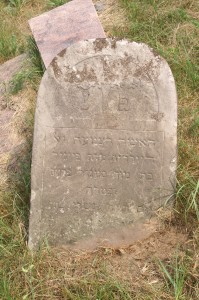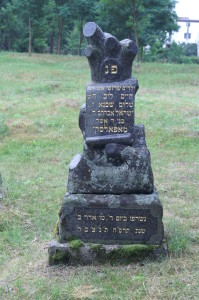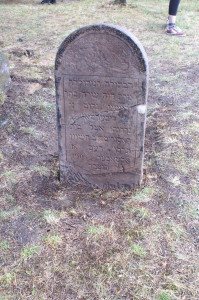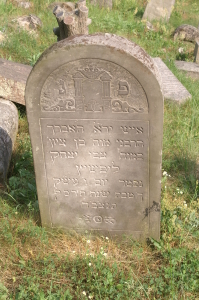
Jewish Epitaph: Formula: The Jewish epitaph through time and history is composed of certain standard components. Frequently, the epitaph opens with the abbreviation פ נ short for “Here lies” poh nitman (m.)/ poh nitmenah (f.) or “Here is buried” poh nikbar (m.) or poh nikberah (f.), typically. Next follows brief epithets of the deceased, such as “modest” or “important” for a woman, and “perfect and upright” for a man. The deceased’s given name, frequently preceded by a title follows. Most often married women are designated as ‘marat’ “Mrs.” while men are acknowledged as ‘mar’ “Mr.” Yet variations in this title are prevalent depending on the age and especially the man’s position as a rabbi and teacher in the community. The paternal lineage of the deceased is then noted, followed by the deceased’s surname. Next follows the date of death, most often according to the Hebrew calendar. The epitaph frequently closes with the abbreviation תנצבה “May his (or her) soul be bound in the bond of everlasting life”, an abbreviation derived first from I Samuel 25:29 (of Abigail to King David), gained its function as a final blessing of a eulogy through its use in the Talmud (Shabbat 152b) and the Yizkor (remembrance) prayer “May her/his soul be bound in the bond of everlasting life together with the souls of Abraham, Isaac, Jacob, Sarah, Rebecca Rachel and Leah, and with the rest of righteous men and women, who are in the Garden of Eden”.
Thus, the most standard formulaic pattern for the epitaph is structured as: Opening Abbreviation, Epithet(s), Title and Given Name, Paternal Lineage, Surname, Date of Death and Closing Abbreviation. In the featured epitaph, this formula is realized as: Here lies/ the God-fearing man,/ the young scholar, our teacher,/ Ben Tzion,/ son of our teacher Tzvi Yitzhak/ Lipshitz./ He died Friday, the eve of the Holy Sabbath, 20 Tevet year 5660 [10 December 1899] as the abbreviated era./ May his soul be bound in the bond of everlasting life.
Yet, this standardized formula does vary, lending the potential to individualize an epitaph with additional details to acknowledge the deceased’s legacy, family heritage and/or regional influences. It is often in these deviations from the standard epitaph formula that the reader is offered an epigraphic portrait not only of the deceased but also of the community in which he or she resided.
Suggested Readings: Joshua L. Segal, Rabbi, A Field Guide to Visiting a Jewish Cemetery: A Spiritual Journey to the Past, Present and Future. Jewish Cemetery Publishing, 2007.
![The epitaph of Rahame Rabinowicz records her date of death as: "She departed in a good name on Thursday, 9 Elul year 5669 as the abbreviated era [13 August 1909]." The word for 'year' is abbreviated. Bagnowka](https://www.jewishepitaphs.org/wp-content/uploads/2014/12/epitaph-date-section-9-2-300x199.jpg)
Jewish Epitaph: The Calendar: Hebrew epitaphs, in general, indicate the deceased’s date of death and, occasionally, date of birth, according to the Hebrew calendar. Days of the month and years are noted using the appropriate letters of the Hebrew alphabet; the calendric month is in keeping with the Hebrew months. Thus, 5 Kislev 5662 is represented as: ה כסליו תרסב . Hebrew letters are used to indicate the days of the week and year. The thousand marker, though attested, is typically not used. Most frequently, the abbreviation לפק “according to the abbreviated [short] era”, indicates the absence of the thousand marker. This basic formula can vary, depending on the expression of choice for a given epitaph composer. Thus, we find the common expression “[S/he] departed 5 Kislev 5662” beside the variant “[S/he departed] 5 Kislev year 5662.” Also common is indication of the day of the week in which the deceased died, for example, “He departed on Monday [day 2 ב]” with Hebrew letters once again representing the days of the week. When the deceased dies on the eve of Sabbath or the Sabbath, respective abbreviations are substituted for the day of death. Presumably entering the day of the week might clarify the precise date of death. When the deceased dies on a holiday or eve of a holiday, notation of the holiday likewise substitutes for the day of death. It is not uncommon to indicate the precise day of the festival, for example, “[He departed] on the 1[st] day of Hanukkah.”
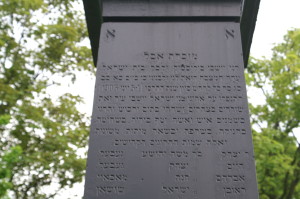
In the Bagnowka corpus, the Old Russian calendar, 13 days behind the West’s Gregorian calendar, was used until 1918. The most prominent example of dating according to the Old Russian calendar is reflected on the Black Obelisk that remembers the 1906 Pogrom and 1905 massacres in Bialystok. The Hebrew inscription offers the dates 18th-23rd of Sivan (1-5 June 1906). The Gregorian calendar records these dates as 13-18 June 1906.
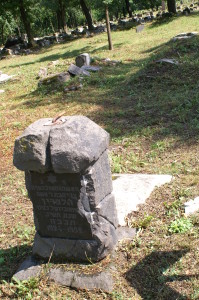
The use of Arabic numerals to indicate date of death, at times, can alleviate any confusion. Throughout the years when Bagnowka Beth-Olam was in use, Polish, German and Russian inscriptions, generally, use Arabic numerals for at least the year of death. Arabic numerals to indicate year of death were also incorporated in Hebrew inscriptions as early as 1910, as in the Black Obelisk inscription; however, such use increased with greater frequency beginning in 1921 and continued through the subsequent years, present even on the most recent extant tombstone dated to 1951. Such practice helped clarify any confusion with the year of death, as the Hebrew calendar follows the lunar cycle, or under influence of western modernity.
Suggested Readings: “The Jewish Calendar.” Judaism 101 http://www.jewfaq.org/calendar.htm ; Hebrew Calendar Converter https://www.fourmilab.ch/documents/calendar/ ; for the Russian Calendar, visit “Of Russian Origin: Old Style and New Style” Russiapedia http://russiapedia.rt.com/of-russian-origin/old-style-and-new-style/ . For information on the 1905 Massacres and 1906 Pogrom, visit Bagnowka Documentation, Section 21 (Coming Soon) and Heidi M. Szpek, “Jewish epitaphs from Białystok, 1905–6: towards mending the torn thread of memory.” East European Jewish Affairs. Volume 41. Issue 1-2 (2011); 1-23.
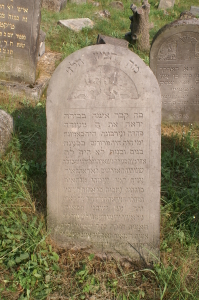
Jewish Epitaph: Punctuation: It is of little surprise when one discovers a symbol upon a Jewish tombstone. More surprising is discovery of punctuation! Punctuation, though largely ignored or overlooked, can be a frequent element in a Jewish epitaph. Most often, it is used for emphasis or to ensure clarity in reading an epitaph. The exclamation point is perhaps one of the most surprising punctuation marks found in the epitaph, especially when the language of the text is Hebrew. The exclamation point is not part of the diacritics of the Hebrew of the Tanakh or of Rabbinic literature. It is standard in Yiddish, the vernacular of Eastern European Jewry. In the Modern Hebrew that eventually developed in Poland, it may have been borrowed from Yiddish. When found in an Ashkenazi epitaph, we cannot be certain whether the epitaph’s composer drew on Yiddish or Modern Hebrew for this punctuation mark. In permitting the traditional Hebrew language to be infused with a ‘modern’ detail, we might suggest that this epitaph bears a hint of assimilation that marked the late 19th and early 20th centuries for the Jewish community, as the traditional world of Judaism confronted a growing world of modernity.
In this featured epitaph from Bagnowka, that of the childless widow Rivke, daughter of Shmuel, wife of Meir Zabludowski (d. 1900), the exclamation point in the upper inscription, compels the visitor to stop, read her epitaph and bring remembrance. “What is this monument!” translates the phrase in the upper inscription of her tombstone. This upper inscription verse, drawn from II King 23:17 (without the exclamation point!), is spoken by the goodly Judahite king Josiah (6th BCE), who after destroying the altar of Bethel and nearby tombs, turned to see another grave, of which he asked, “What is this monument that I see?” It was the tombstone of the Judean man of God, who foretold Josiah’s actions. The words of Josiah beg inquiry into the Judean man of God; in Rivke’s inscription, these words prompt the reader to read further. Her epitaph goes on to describe Rivke Zabludowski as an honorable and God-fearing woman. After the death of her husband, her epitaph records that she remained barren and childless. Indeed, her latter years became even more challenging “as her eyes did not see light.”
Suggested Readings: II Kings 23; “Hebrew Literature” YIVO Encyclopedia Online.
Jewish Epitaph: Woman in Confinement: Prior to the demise of the Ashkenazi epitaph (c. 1920), epithets for the deceased offered some standard epithets. Some of these terms, such as “modest” and “important” are ideal and perhaps part of a common epitaphic vocabulary. But exceptions do occur. In the epitaph of Feigel Pres (d. 1893), she is described as a יולדות “a woman in confinement’, a designation that refers to a woman who died near the end of her pregnancy, in labor or in the traditional post-partum period, 8 days for a boy child; 20 days for a girl child. At the end of the 20th century, pregnancy posed a danger to mother and child, and death was not uncommon, the causes being both medical and due “to the influence of the world of demons and evil spirits”, especially the demon Lilith. At Bagnowka Cemetery, at present, in the first decade (1892-1902), 75 epitaphs of deceased women are extant, six of which designate a woman as having died ‘in confinement’. Beyond this decade only three other epitaphs, dating to 1904, 1910 and one with no date, are extant. Bialystok had a hospital since 1872, established by the affluent businessman Izaak Zabludowski, however, the epitaphs of Bagnowka still suggest medical advances in pregnancy and childbirth were lacking.
The candelabrum above Feigel’s epitaph emphasizes her premature death, as evidenced by the broken two side candles. Her epitaph reads:
Here lies the modest, God-fearing woman, the woman in confinement, Mrs. Feigel, daughter of our teacher Sender, Pres. She died on Thursday, 4 Tishri year 5654 [2 September 1983] as the abbreviated era. תנצבה
Suggested Readings: “Birth and Birthing”, “Childbearing”, “Health and Healing”. YIVO Encyclopedia Online http://www.yivoencyclopedia.org/ . For death due to childbirth in the Sephardic tradition, see the epitaphs of Suriname as documented by Aviva Ben-Ur and Rachel Frankel in their Remnant Stones: the Jewish Cemeteries of Suriname. Volume 1: Epitaphs. Hebrew Union College Press, 2009.
Jewish Epitaph: Death by Fire: On 5 March 1908, fire consumed the glasswork factory and mercantile of Reb Oszer Topolski, located on Bazarnaya Street in Bialystok’s Jewish business district. A solitary matzevah is the only extant witness to this devastation, which claimed the lives of Oszer and Rochel Topolski’s three youngest sons. Near the memorial complex in Bialystok’s Bagnowka Jewish cemetery stands this matzevah, shaped like a tree trunk whose branches are severed, symbolizing life cut short. The epitaph reads:
“Here lies children burnt [in a] fire. It is indeed Chaim Leib, 8 years old], Shalom Shechna, 6, Yisrael Avraham, 4, sons of Reb Oszer Topolski. They were burnt on Wednesday 15 Adar II year 5668 [= 5 March 1908]. תנצבה”
The Bialystok Death Record similarly lists cause of death for each boy as “burnt to death during the fire” (сгорела во время пожара). It was not uncommon for buildings to be constructed of wood in the 19th century and early 20th century, especially in the poorer sections of town. In 1885, Grodno burnt down as fire spread from one wooden building to another. Though not frequent, it was not uncommon for a matzevah to remember more than one deceased (see entry under Tombstones: Multiple Burials). In this case, the circumstance of the loss of three sons, amidst a single devastation, suggests the desire for a single matzevah to bring remembrance. Such a memorial emphasizes the tragedy of this loss.
Within this cemetery, the matzevah of the boys’ older brother, Pinhas, can be found in the disarray of section 2. Pinhas perished at age 18 on 17 December 1912. His matzevah also shaped like a broken tree stump emphasizes his youthfulness, prematurely cut short. His epitaph describes him as “an important young man, our teacher”, language typically used of Torah students and young teachers. In 1908, at age 14, Pinhas for some reason survived the fire that claimed his younger brothers’ lives. The cause of his death, at present, is unknown. Together, the legacy of the two matzevoth shed light on the harshness of life in early 20th century Bialystok and Eastern Europe. Their father, Reb Oszer Topolski, was a prominent community member in Bialystok, who served as a committee member for the development of the new state school in Bialystok in 1914, and participated in the reorganization of community institutions, the first of which was the Linas Ha-tzedek charity organization. As a community leader, Topolsky was present to oversee the victims of the August 1920 Pogrom. The Bialystoker Photo Album preserves a photo of Oszer Topolski and Rabbi Rappoport with the victims of this pogrom. One final record notes that Oszer Topolski emigrated to Palestine in 1926. The fate of his wife, Rochel, is unknown.
Suggested Readings: “Hrodna”. The YIVO Encyclopedia of Jews in Eastern Europe Online http://www.yivoencyclopedia.org/article.aspx/Hrodna ; Bialystoker Photo Album, especially p. 79, available at: http://yizkor.nypl.org/index.php?id=2976 .
See also Tombstones: Double Burial.
Jewish Epitaph: Storming the City Prison, 1905: On 18 October 1905, according to the Julian calendar, the revolutionary youth of Bialystok stormed the city prison. The day before, Tsarist authorities had issued a memorandum promising the release of political prisoners. Lacking their release, the Jewish revolutionaries attempted to take matters into their own hands. Amidst the fighting, shooting broke out. Four men and one woman were killed, with many wounded. The names of the victims are preserved at the bottom list on the fourth façade of the memorial pillar near the center of Bagnowka Jewish Cemetery. This memorial remembers victims of the 1906 Pogrom, the 1905 Sabbath Nahamu massacre and the 1905 City Prison storming.
Near the memorial stands the matzevah of the female victim of this conflict – Chava Lieberman, who died from wounds received from bullets. Chava’s gravestone, newly mended and re-erected (2014), again stands in the memorial complex, beside female victims of the 1906 Pogrom in Bialystok. The symbol upon her matzevah depicts her life cut short via a bird plucking a flower in bloom. Her epitaph offers both an upper and main inscription:
Upper:” She was killed beside the city prison by murderous hands on Tuesday, 2 Marcheshvan 5666.
Main:” Here lies a praiseworthy, unmarried woman, Miss Chava Sora, daughter of R. Yehoshua Nachum, may his light shine, Lieberman. She was killed beside the city prison, 2nd Cheshvan 5666, the 18 October 1905. תנצבה”
The phrase “house of prisoners”, i.e. a prison, used twice in this epitaph, is an expression drawn from Jeremiah 37:15, where it designates the place in which the 6th century BCE prophet was imprisoned. Lacking a technical word for prison, the Hebrew language of the epitaphs drew upon the biblical text. Equally interesting is the use of Arabic numerals in writing the vernacular equivalent for the Hebrew date. Here 18 October 1905 uses the Arabic numerals and the Yiddish word for October. This year follows the Julian calendar still in use in Russia, which included Poland, until 1918.
Suggested Readings: Jeremiah 37; Avraham Shmuel Herszberg, Pinkos Bialystok. Volume II. Chapter 5.B. Online: http://www.jewishgen.org/yizkor/Bialystok/bia2_114.html; Heidi M. Szpek, “Jewish epitaphs from Białystok, 1905–6: towards mending the torn thread of memory.” East European Jewish Affairs. Volume 41. Issue 1-2 (2011); 1-23.
